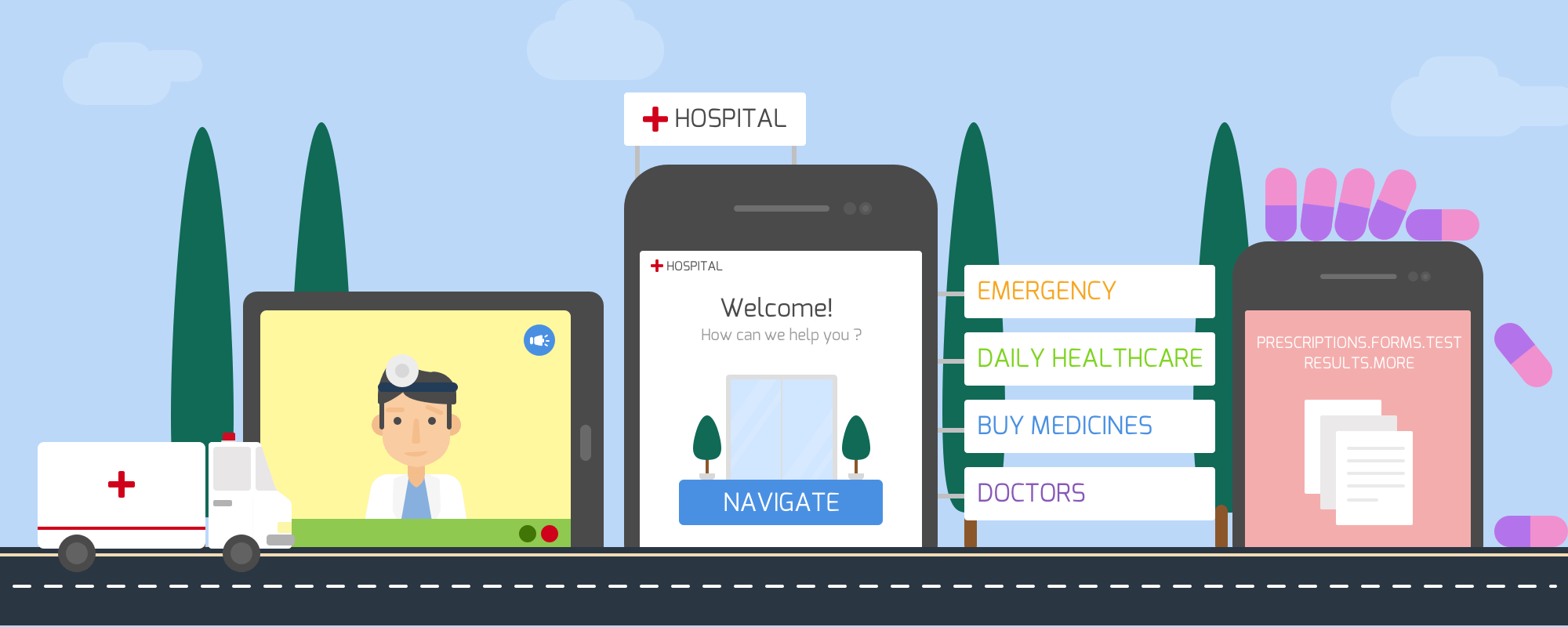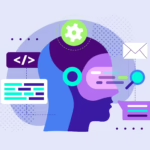Disruptive Design: The powerful impact of design in improving healthcare

Technology in healthcare
Do hospitals in India need a facelift? Is it time to revolutionize the way healthcare is delivered? Will future hospitals be designed around the patient? Is it unbelievable to imagine a hospital visit stay as seamless as a night in a hotel?
Well, whether you are visiting the hospital for the first time or you are a regular patient, with every patient’s circumstances being unique, their associated treatment, and thus experience, should be personalised as well. In India, investment & employment in Healthcare is one of the fastest growing sectors of interest. But, anyone who has spent a night in hospital will know how adverse the experience is. Let’s jump into the shoes of a patient and understand how a typical outpatient hospital visit looks today.
Difficulties faced in today’s hospital system
- Lack of instructions for the patients to locate labs, OPD’s, wards in hospital
- Long waits between or before appointments, including delays in being moved between different departments
- Human errors like wrong drug or wrong dosage (medication errors)
- Staff not keeping patients & their family well informed
- Inadequate response to requests or complaints
- Estimate given by the hospital regarding expense, is less than actual
- Not keeping whiteboards updated with patient information.
- The way the hospital doctors do rounds on their patients up and down the hospital is completely haphazard at the moment. One patient may get seen at 7am and another at 3pm. Often there’s no rhyme or reason behind the timing — it’s just about where the patient happens to be located in the hospital.
- Patients are not educated about the different tests and the purpose of these tests clearly.
- The discharge process is fraught with potential problems by its very nature.
- Crowded halls waiting for their turn.
- Self help kiosks are useless. They do not present the most important information upfront
- Insufficient lab facilities including working equipments in comparison to number of beds
- Inadequacy of health personals to give health education to patient
The Next generation of Healthcare
Many new innovative solutions have emerged as hospital centers and physician groups across the country strive to deliver service on their patient’s schedule. Practo, Portea, Qikwell are all examples of such new technologies focused on making it easier for patients to receive better care.
But, there does not yet exist a healthcare solution that interacts directly between the hospital and the patient, directly contributing to improving the patient experience in a meaningful way along the entire continuum of care. Instead, each of the existing tools are siloed approaches and do not truly address the real need.
Ideally, hospital needs an integrated healthcare system which integrates every aspect of healthcare to ensure smooth transition of patients from one type of care to another. Also every technological novice entering the hospital walls should integrate seamlessly into the workflow, saving doctors’ time and efforts.
What is Integrated Healthcare?
“It is about linking every aspect of healthcare, ensuring professionals and individuals have access to all the information they need”
This includes everything from the moment a patient first contacts their provider, to remote monitoring patients at home, up through long-term treatment of chronic conditions.
Hospitals face a constantly flow of incoming patients with different needs. Patients struggle to fill their enrollment form, they find it difficult to locate different departments, doctors, not to mention labs, radiology and other locations. Patients get annoyed waiting for their turn between or before their appointments. The list is endless. The need of the hour is to streamline and integrate patient, asset and hospital workforce flow throughout the hospital, ensure that operations and procedures occur on time and facilitate clear communication across departments.
We need a solution that acts as an effective tool for communicating patient needs to their physicians in an actionable timeframe. A digital solution that simplify the patient experience across the entire patient journey from appointment scheduling to discharge. We aimed to examine existing models in the hospitals to address the multiple issues faced by the patients in the hospital. We have summarized the basic difficulties what a patient faces in today’s hospital system below:
Design Driven Solutions
Patient beds with Smart screens: Patient beds can have patient information screens which can be accessed by Doctors, Nurses and patients. Doctors and nurses can access patient information prior to entering an exam room to enable informed conversations. Also patient can access his case history, different medication and treatment he/she is undergoing. Patient can also enter data here like symptoms, explain his illness, enter his family’s medical history, etc.The Nurse also can enter the different dosages of medicines they have given to the patients and all patient relevant data on the smart screen instead of documenting it on paper. Patient’s heart rate, BP, SPO2, etc will be directly uploaded on the cloud from the smart patient monitor. So, all data entered by the doctor, patient, nurse and the patient monitors will be recorded on one platform and can be directly accessed from the cloud. The hospital system can be designed to be fully paperless, which lets the medical personnel to manage patient data electronically.
Smart Bracelets: A fitbit kind of bracelet which measures various parameters of the patient like body temperature, heart rate, Blood pressure, etc. can be given to the patient once he has enrolled to the hospital. In case of any abnormal readings the smart bracelet should notify doctor and it should be able to upload the data on cloud which doctor can easily access. This Smart bracelet also keeps track of the patient location. Such smart bracelets enables you to benchmark and track patient flow in real time from admission to discharge.
Inhospital teleconferencing technology: Doctors instead of going for rounds visiting each patient can have a video call with their patients and only in case of emergency can visit the patient. Teleconferencing is more useful in clinics and outpatient departments. Also in operation theatre teleconferencing lets the operating doctor talk to the pathologist without leaving the room.
Displaying wait times: The hospital website, mobile app and their information screens should display the current average wait times, which can be updated in real time. Wait times and token numbers for different departments can be displayed here (Just like the train timings are displayed on tv’s in railway station). This will keep the patients apprised of the wait times and reduce the long waits between or before appointments. Patients will atleast have an estimate around what time they can meet the doctor.
Geo-locator hospital guide: Free wireless internet access at the entrance or a QR code at the entrance which once scanned opens up the visitor’s guide of the hospital. This location enabled guide will have a visual map of the hospital with a geo-locator that will guide the user to locate a particular location.
Easy Discharge: The patient should be able to make payment online. The hospital website can have an option to make online payment. Once the payment is done patients can bypass the front desk upon discharge as their bill, discharge documents and other necessary patient reports can be mailed to the patient’s mail id or their family member.The e-discharge can also have a summary report which answers basic questions for every patient. (Bathing and Showering, Diet – what to eat, what to avoid, Driving, Incision and dressing care, Medications – dosages and when to take, Pain control – what to expect, what to do, Physical activity, Physical and occupational therapy, Resuming sexual relations, Returning to work, Signs of infection, when the patient should come for next consultation, etc)
Smart Patient enrollment: The patient should be able to make online enrollment instead of standing in the queue. The hospital can have a QR code for enrollment which the patient or his family member can scan and the hospital app opens up. Then the patient details can be filled online and submitted (for a general checkup, payment can be made online). Then a notification will be sent with patient details like patient id, appointment number, ward number, doctor name, etc.In case the patient doesn’t have a smartphone he can still use the hospital kiosk. He can fill in the details or scan his Aadhar card and use his fingerprint for enrollment thus cutting the queue.Let us take up a user journey and see how the proposed integrated healthcare solution helps to provide a seamless experience for the patient.
Imagine a patient is suffering from a chronic abdominal pain. He decides to consult a doctor and hence books an appointment online with a Gastroenterologists. At the scheduled time he visits the hospital and as he enters the hospital he scans the QR code at the entrance and downloads the Geo-locator hospital guide which guides him to the gastroenterologists cabin. The doctor diagnoses the patient and asks him to get admitted to the hospital and also get an X-ray done. The patient gets enrolled online using his hospital mobile app where he gets to select the room according to his preference. The patient can enter all his basic details in the app during enrollment where he will be allotted a patient id and the ward number.
Using the Geo-locator the patient navigates to his ward room. Then a smart bracelet will be given to the patient which monitors his body temperature, blood pressure, heart rate, etc. The patient bed has a smart screen which he can login with his patient id. The smart screen will display all the patient details – his case history, billing amount, medications, reminders, etc. The smart screen will also display the time when the patient has to go for an X-ray test. The patient then gets his X-ray test, the reports of the same will be uploaded on the cloud.
The doctor who can access the reports from cloud analyses the reports and finds the problem and provides the necessary treatment to the patient. Here the nurse can also enter the regular dosage of medicines what she has given to the patient on the smart screen. So all the patient records are available in the digital form. The smart screen will also display when the patient will be discharged. The discharge procedures can also be fulfilled online with easy online payment. Once the payment is done the patient summary report will be mailed to his mail id. Such holistic design driven approach will make the patient’s life easy and hassle free.
Conclusion
Patient experience is an important focus area across healthcare and it is critical to provide more customized approach to every patient’s care. Like it or not, the increasingly digital world is now also shaping patient expectations when it comes to their care. Healthcare organizations must do more than providing average experience to their patients.
A holistic approach addressing the entire patient experience is needed which lets the healthcare provider to act on the patient needs in real time. The solution provided need to focus on better integration of all the components of healthcare with the physician-patient experience that enables patient engagement, rather than detract from it.
Healthcare has many bits and pieces. Are yours in the right place? If not, then NetBramha have got you covered to seamlessly capture data and present solutions which are more consumer-focused enhancing the patient experience.
Disclaimer: The information provided does not in ANY way represent any particular hospital. The information provided is for creating awareness and is for education purpose only. We bear no responsibility for the use (or misuse) of any information given on this blog or accessed through our website.


